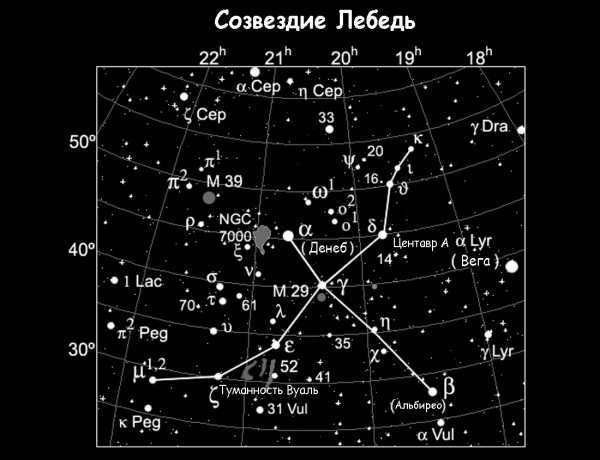
During a pleasant summer evening, when the shimmering gray ribbon of the Milky Way stretches across the sky from one end to another, a sight awaits you high above, nearly at the zenith—an extraordinary celestial creature, the Swan constellation. It is arguably the most iconic among the 88 constellations that adorn the heavens.
Observing the constellation: when and where
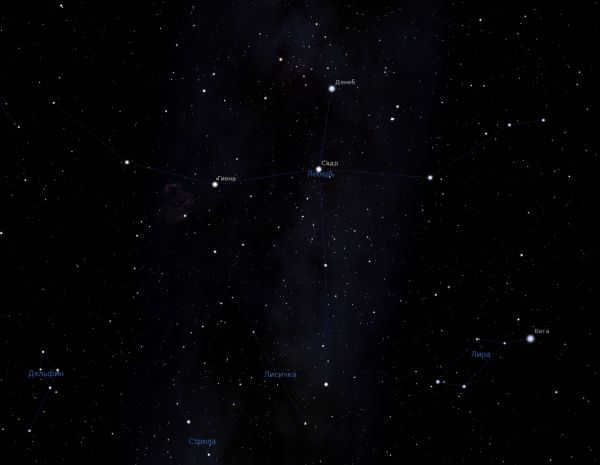
The Swan constellation (Cygnus) is a partially non-setting constellation in the middle latitudes of the Northern Hemisphere. Its brightest star, Deneb, is always visible and never hidden behind the horizon. The ideal time to observe this constellation is during mid-summer.
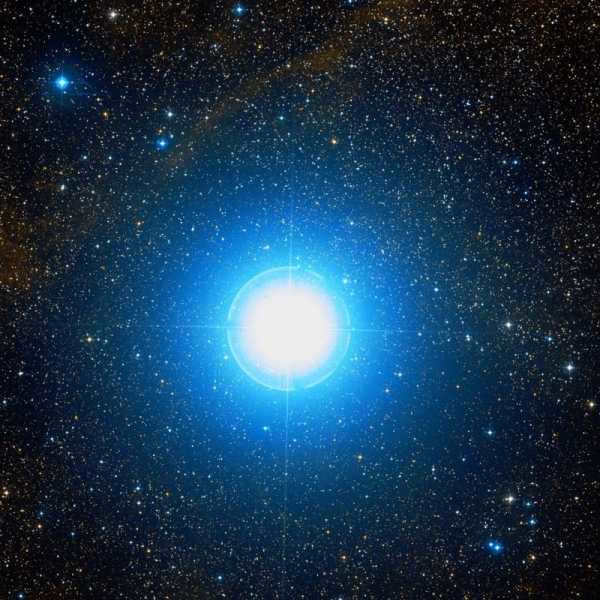
The initial stars that attract attention are the five stars that create a distinctive cross (occasionally referred to as the Northern Cross, which is a rather outdated term for the constellation). These stars, α, β, γ, δ, and ε Cyg, are the most brilliant in the constellation, with Deneb (α Cyg) leading the way.
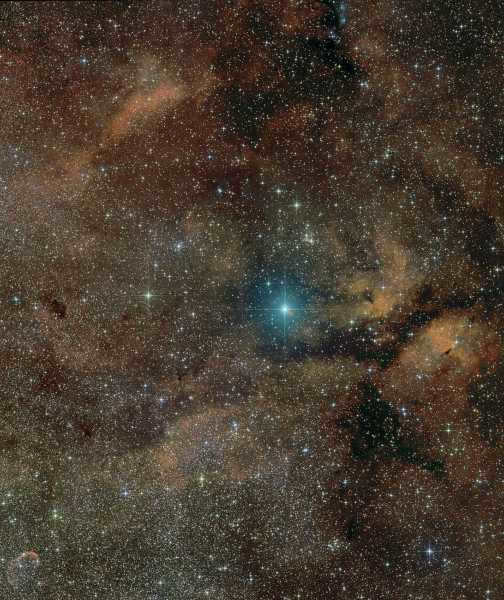

The γ Supergiant Star of Swan
When combined with the stars ζ and ι Cyg, the aforementioned five stars create the well-known outline of the flying bird moving towards the Southwest.
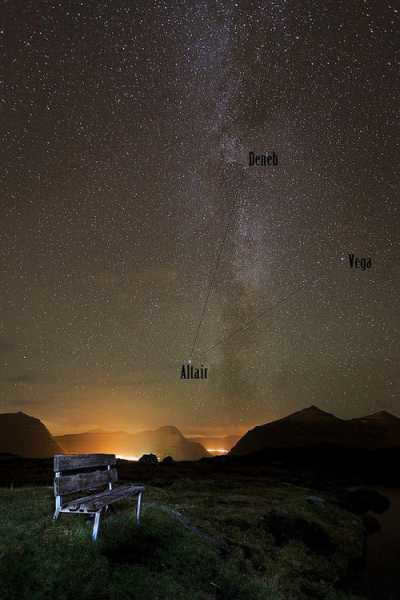

The Summer Triangle can be observed from the Faroe Islands.
In addition, the Summer Triangle is made up of three stars: Deneb, Altair (α Eagle), and Vega (α Lyra). These stars create a distinct pattern in the sky known as an asterism. Deneb, the star representing the head of the Swan, is a blue-white star that is significantly larger than our Sun and has a brightness of 1.25 stellar magnitudes.
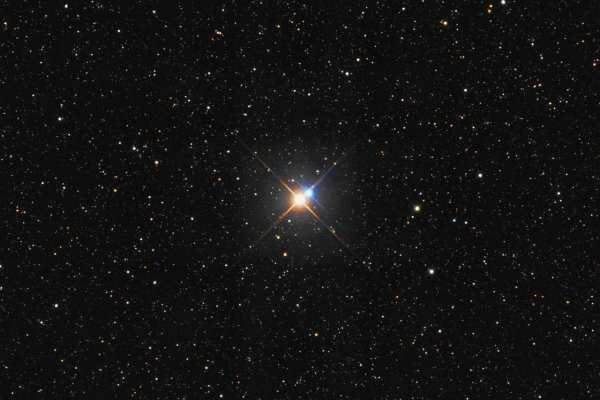
The star Albireo, also known as Beta Swan, is one of the most stunning stars in the Swan constellation. While it may not be the brightest star, its beauty is unparalleled. Albireo is actually a double star system with Albireo A and Albireo B as its components. Albireo A is an orange giant with a stellar magnitude of 3.4, while Albireo B is a slightly dimmer blue star with a stellar magnitude of 5.1. When viewed through a telescope, the visual experience is truly breathtaking. The contrast between the orange and blue hues is simply amazing. To fully appreciate the picture, a magnification of 60-100x is recommended.
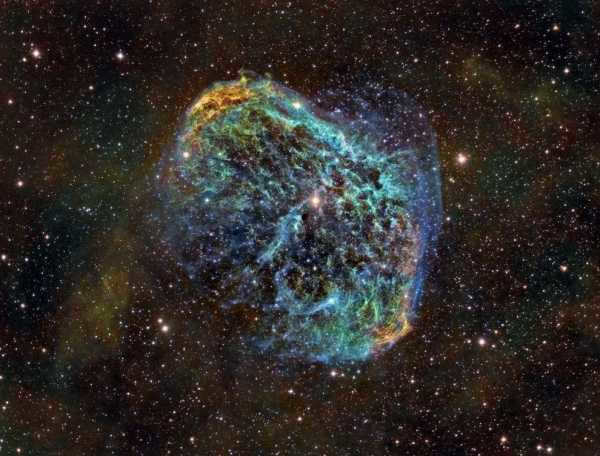
The Crescent Nebula, designated as NGC 6888, can be observed through a telescope.
Additional celestial bodies suitable for telescope observation
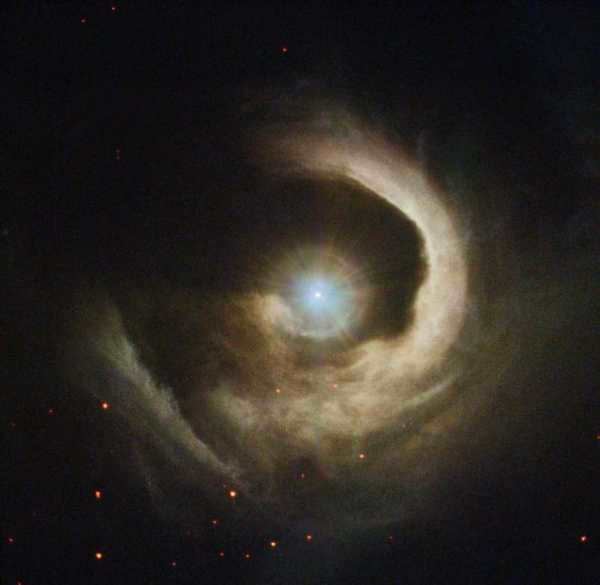

This Hubble image showcases the beautiful nebula that surrounds the star V1331 within the Swan constellation.
There is another interesting multiple system within the Swan constellation, which can even be observed with the naked eye. It is situated between the stars α and δ Cyg and consists of two 4th magnitude stars called Omicron 1 and Omicron 2.
If you look closely with 7×35 field binoculars, you will notice that instead of seeing just one star at the position of Omicron 1, there are actually two stars of 4th and 5th magnitude. This system has an additional third component. However, to see it, you will need to increase the magnification to 15 – 20x. Once you do, another star of 7th magnitude will become visible near Omicron 1. That’s right, it’s actually a multiple system consisting of four stars.
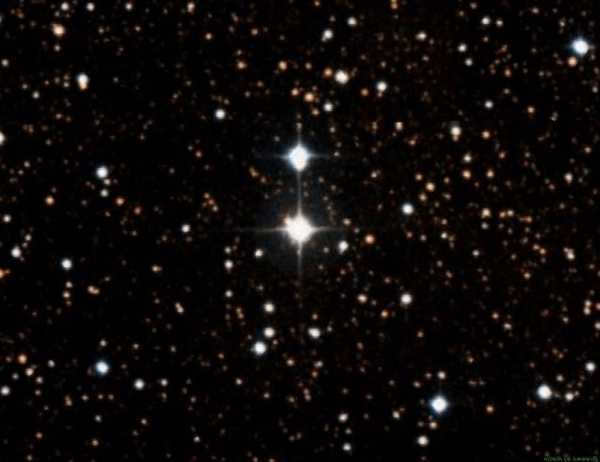
Swan X-1 in the optical
Located one and a half degrees NNW of ε Cyg is an exceptional star known as Swan X-1. This star emits powerful X-rays and is also a variable star, with its brightness fluctuating between 5.9 and 6.9 magnitudes in a period of just 16.39 days.
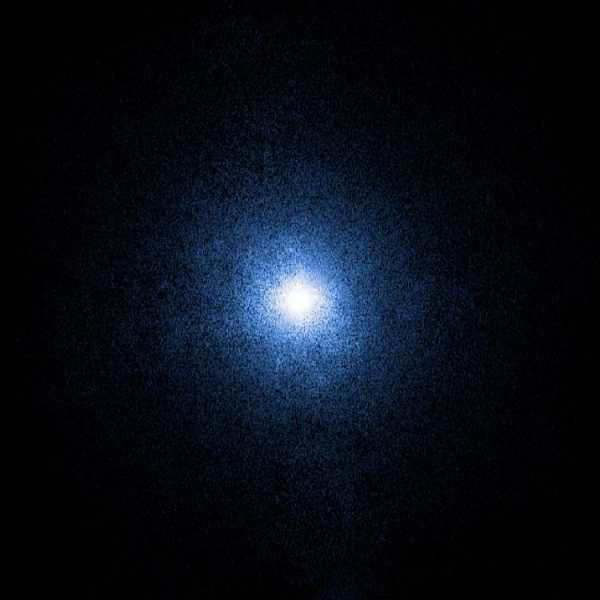
X-ray image depicting Swan X-1.
Swan X-1 is recognized as the most luminous X-ray source and was initially considered a potential candidate for black holes.
61 Cyg, a binary star system located in the Swan constellation, is another highly significant celestial body for scientific research. It is the first star whose distance has been accurately calculated through parallax measurements, amounting to 11.36 light years.
The annual proper motion of 61 Cyg.
It is actually a star in close proximity to Earth and one of the rare stars visible to the naked eye that showcases substantial proper motion. In the early 19th century, Giuseppe Piazzi referred to 61 Cyg as a “flying star.”
Describing Objects in the Far Reaches of Space
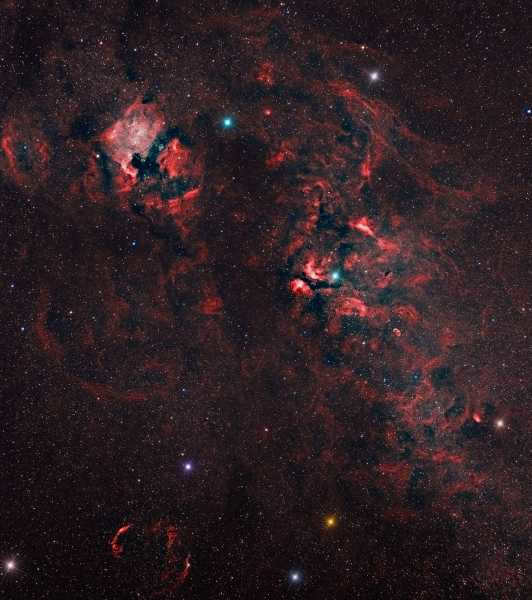
The Swan constellation is known for its stunning Milky Way region. In addition to its impressive collection of stars, the Swan constellation is home to a multitude of celestial objects in the distant reaches of space. With over two dozen scattered clusters, various emission clusters, and an abundance of dark nebulae, there is no shortage of wonders to explore. To fully appreciate these celestial gems, it is recommended to equip oneself with powerful binoculars, such as the 15×70 model.
Discovering the wonders of the Swan constellation
The Coal Sack in the Northern Hemisphere
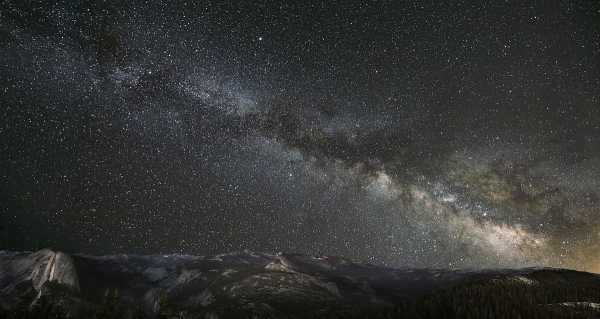
The Northern Coal Sack can be found just below Deneb in the sky.
To begin, let’s journey from the southwestern part of the constellation towards the northeastern direction. As we do, we will gradually spot each of these celestial objects. They will appear to float amidst the backdrop of the Milky Way’s starry scattering, occasionally revealing darker “pockets”. These pockets are actually dark nebulae, which are composed of cold and thinly spread interstellar matter. One such nebula can be found slightly south of Deneb and is known as the Northern Coal Sack (resembling the Coal Sack located in the Southern Cross constellation).
Observations of the mysterious dark cloud
The enigmatic Northern Coal Sack can be most effectively studied using wide-angle binoculars at low magnifications, up to 5x, or simply by gazing at the sky with the naked eye on a sufficiently dark and unobstructed night. In either scenario, one can behold a shadowy “deficiency” of irregular elongated form, from which a dark streak extends to the southern region.
Nebula North America and Pelican
Nebula North America and Pelican are two companies that have joined forces to create a powerful partnership. This collaboration brings together the expertise and resources of both companies to deliver innovative solutions in the field of technology. With Nebula’s cutting-edge cloud services and Pelican’s industry-leading hardware, the partnership aims to revolutionize the way businesses operate. Together, they are poised to lead the market and shape the future of technology.
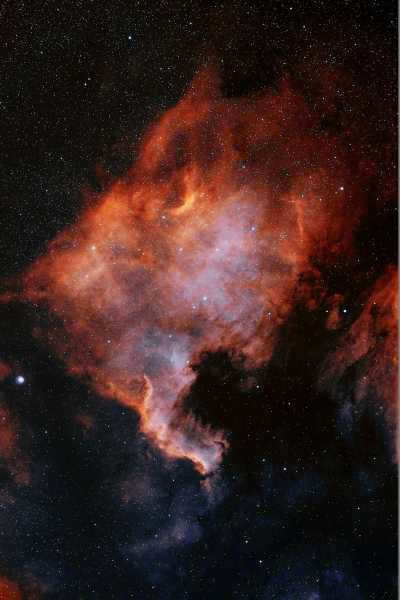
Image of NGC 7000 merged together
Starting our search from Deneb, we can locate the emission nebula NGC 7000, also referred to as North America. This particular nebula is quite prominent and can be easily observed.
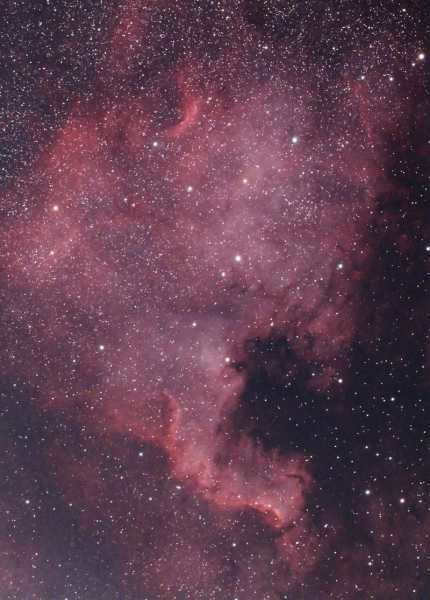
The Nebula of North America
This nebula has a star magnitude of 4.5, but its surface brightness is not very high. This is due to its impressive emission area, which barely fits within 2.5 degrees. It is also not surprising that it is not easy to locate North America at first glance. Furthermore, its contrast with the relatively bright star clouds of the Milky Way is rather small.
NGC 7000 Observation: A Closer Look at the Nebula
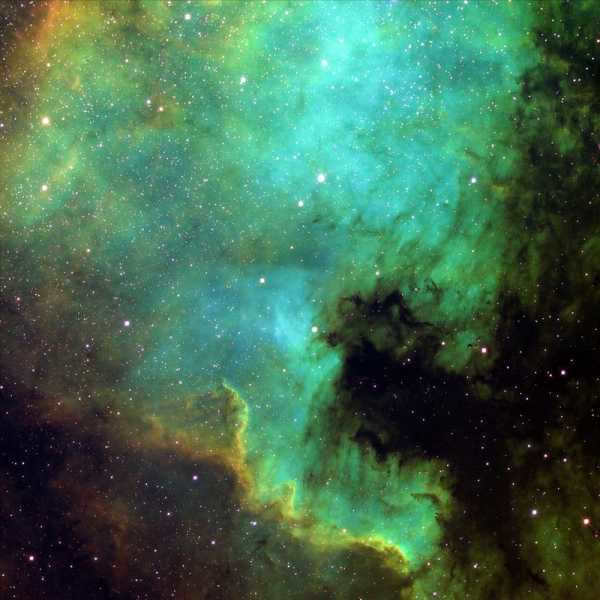
When gazing up at the night sky in a rural or suburban area, one can easily spot a faint glow approximately three degrees to the east of the star Deneb. However, when you use binoculars to observe the exact location where the glow was visible to the naked eye, it becomes more challenging to see as it blends into the vast expanse of the Milky Way. To locate NGC 7000 using binoculars, it is actually easier to focus on the dark region that resembles the “Gulf of Mexico” within the celestial “continent” rather than the glow itself. By finding this dark area, it becomes much simpler to identify the distinct shape of the nebula.
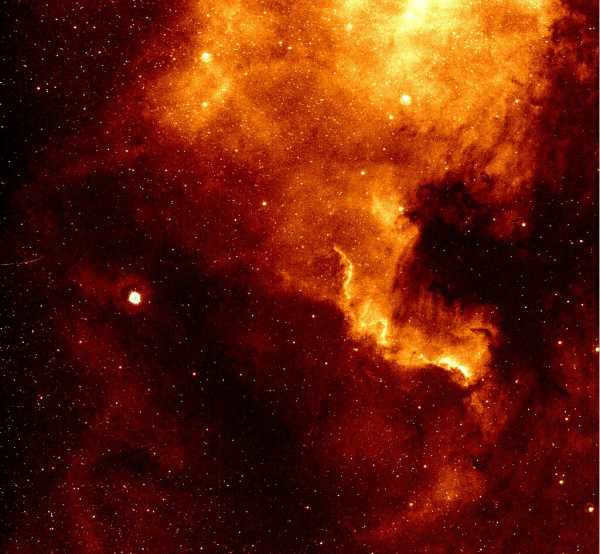
This hydrogen cloud, which serves as a nursery for stars, offers a breathtaking sight when observed through high-powered binoculars. The sheer size of the nebula becomes apparent at 15-20x magnification. Along the northeastern edge of the “continent,” individual strands of gas are visible, creating a border of softly glowing threads. The background of the nebula not only emits a noticeable luminosity but also showcases countless stars, forming a mesmerizing gradient.
Additional information about the nebula
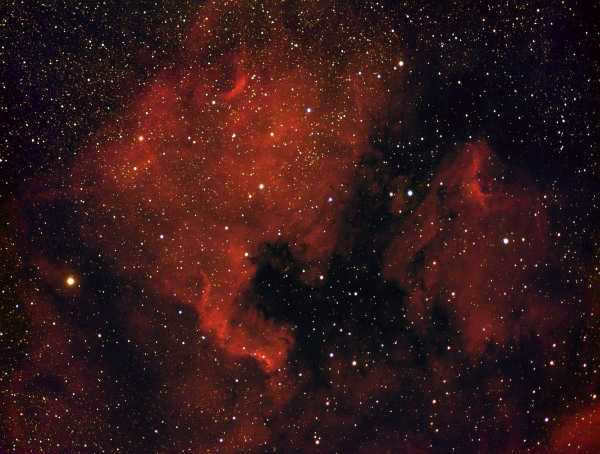

NGC 7000 has been captured using a filter specifically designed to capture hydrogen emissions.
The southwestern portion of the nebula, resembling the shape of Mexico, stands out prominently, with a clearly visible dense glowing filament along its southeastern boundary. In contrast to the commonly held belief that increasing telescope aperture and magnification enhances detail, this is not the case for NGC 7000. On the contrary, the larger the telescope aperture and magnification, the more challenging it becomes to discern the nebula against the backdrop of the Milky Way’s star clouds.
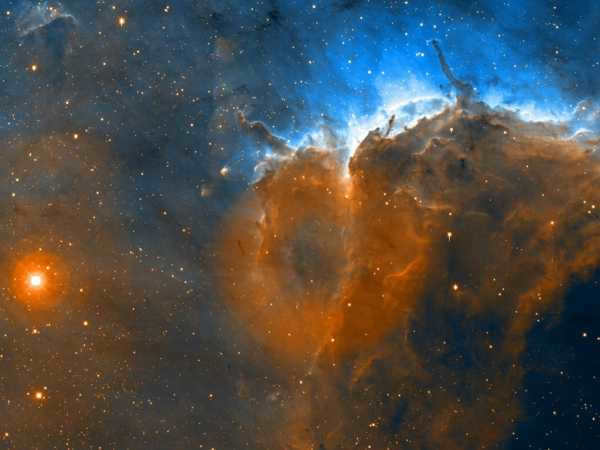
On the other side of the “Gulf of Mexico,” lies a distinct nebular location known as the Pelican Nebula. Although they may seem separate in the sky, both America and Pelican are actually part of a large region consisting of doubly ionized hydrogen, with a dust band dividing them.
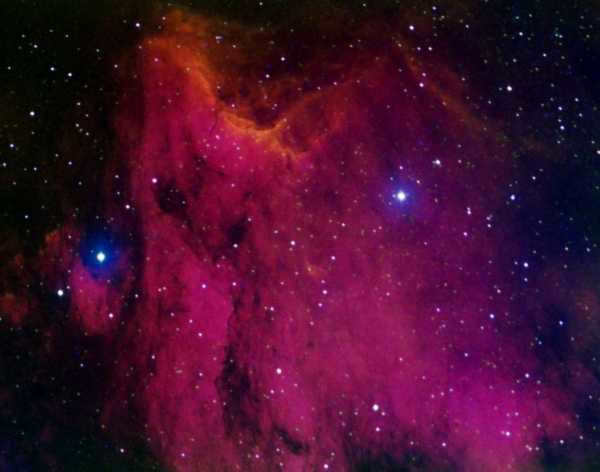
IC 5070, also known as the Pelican Nebula, is an emission nebula.
M39 is a diffuse cluster.
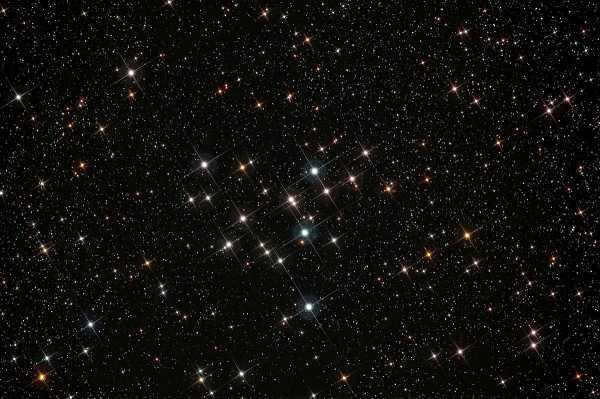
Starting from Deneb, we can move approximately 8 degrees towards the Northeast to find our next celestial object, the M39 Scattered Cluster. Even with the simplest pair of binoculars, we will be able to observe around twenty-four stars arranged in the shape of a heart. If we use a telescope with a larger aperture, we may notice a subtle blue hue in the stars’ glow.
The M29 star cluster
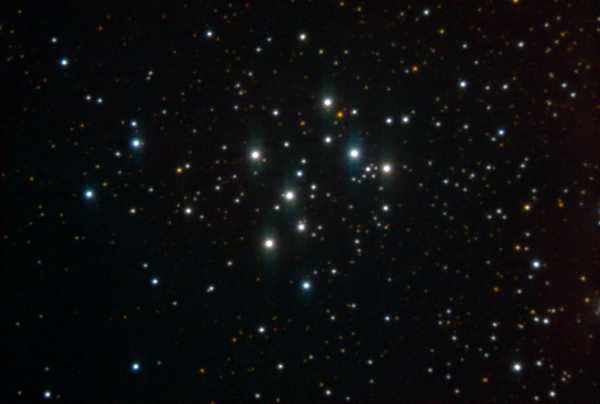
M29 is the following and final item in the Messier catalog’s constellation M29. It can be found approximately two degrees away from Sadr (γ Cyg). When observed through small binoculars, this group of stars appears as a tightly packed cluster surrounded by a bright halo. When viewed at a magnification of 20-30x, the cluster separates into twelve individual stars arranged in an interesting geometric pattern, resembling both a rectangle and a triangle.
The Veil Nebula
The Veil Nebula is a celestial object located in the constellation Cygnus. It is a large supernova remnant, which means it is the remnants of a massive star that exploded in a supernova event. The explosion created a shockwave that expanded outward, leaving behind a beautiful and intricate structure of gas and dust. The Veil Nebula is estimated to be around 8,000 years old and is approximately 1,400 light-years away from Earth. It is a popular target for astronomers and astrophotographers due to its stunning appearance and scientific significance. The intricate filaments and colorful gases make it a captivating sight in the night sky. The Veil Nebula is also a source of ongoing scientific research, as astronomers continue to study its structure and composition to better understand the life cycles of stars and the processes that occur during a supernova explosion.
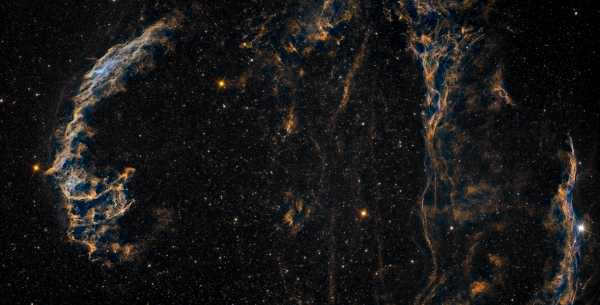
An extraordinary entity is positioned nearly at the midpoint of the direct line that connects ε and ζ Cyg (in fact, 0.5 degrees towards the Southwest). This nebula is the residue of a supernova that occurred within the constellation approximately 5,000 to 8,000 years ago. It is now identified as NGC 6992 or the Veil Nebula. The Veil Nebula is relatively close to our location, only 1400 light-years away, enabling us to observe a plethora of intricate features even with telescopes of lower aperture.
Observations of the celestial cloud
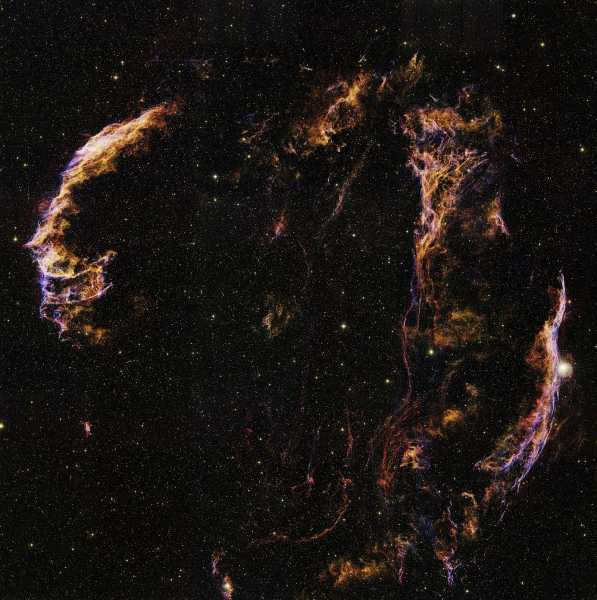
The Swan Loop Nebula is visible in its entirety.
When observing with field binoculars on a clear and very dark night, we can easily distinguish the thin nebular filaments of its northern and southwestern parts. This task becomes simpler as the aperture size increases. Even with 15×70 binoculars, the curved shape of the Northern Wing of the nebula is clearly visible. There is some variation in its brightness, causing the Veil to appear fragmented into separate clusters rather than a continuous ribbon.
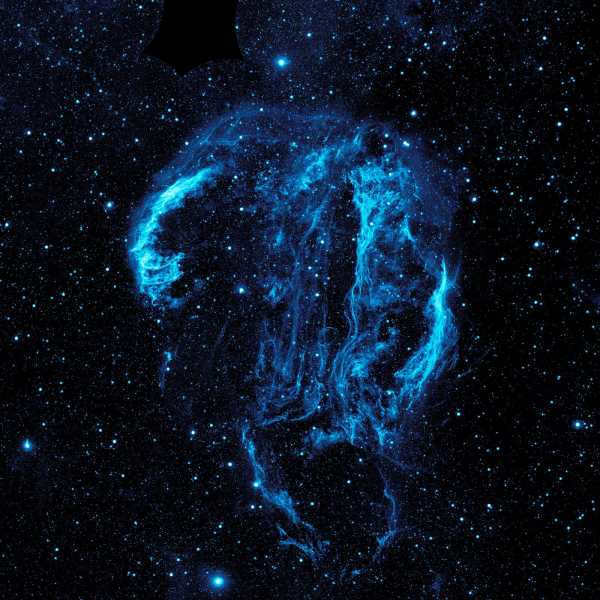
UV image of the Swan Loop Nebula
It is quite simple to observe all three components of the nebula using a medium telescope with an objective diameter ranging from 90 to 120 mm. Even with a direct view, the nebulae can be clearly seen. However, with a larger aperture telescope ranging from 6″ to 8″, the intricate pattern of fine dust fibers starts to become visible, revealing even more details.
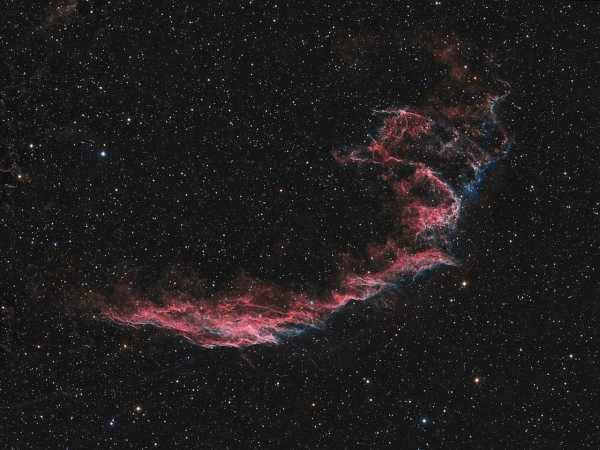
It is worth mentioning that using more advanced instruments for observation may cause some inconvenience due to the fact that the entire nebula cannot fit in the field of view, requiring you to navigate through its flow. However, the most awe-inspiring experience of observing the nebula can be achieved using a large astronomical binocular.
Embarking on a Journey to the Veil Nebula
The Nebula of the Witch’s Broom
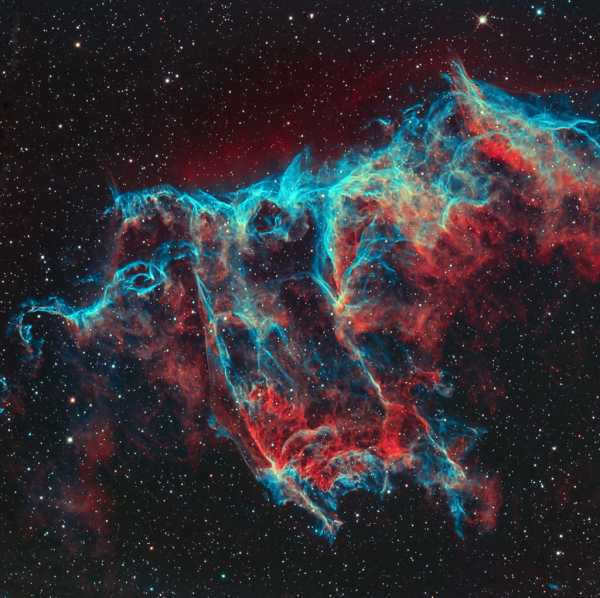

Another portion of the remnant from a supernova is known as NGC 6960 or the Witch’s Broom. It can be easily located due to the presence of a bright (4.8m) blue-white star called 52 Cyg, which is situated near its center. Despite its proximity to the supernova remnant, it is not connected to the nebula in any way and is simply projected onto it.
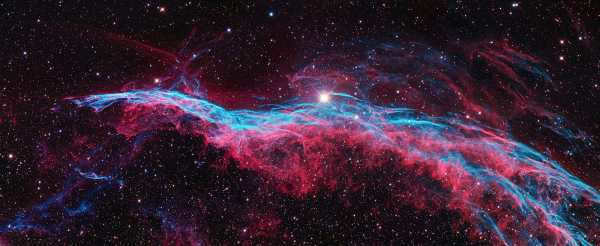
The brightness of the Witch’s Broom is equivalent to that of the Veil. When observed through a small telescope, it appears distinctly visible against the backdrop of the Milky Way, resembling a shimmering stream of light extending from the East to the West. In order to discern the intricate details of the delicate interweaving patterns, a telescope with a minimum aperture of 6″ is required.
Dispersed groupings NGC 7082 and 7039
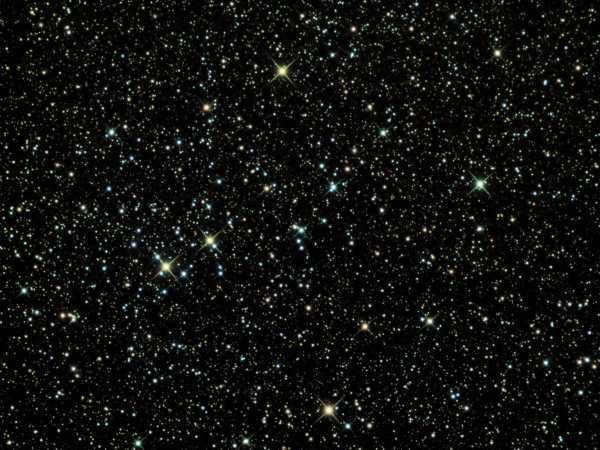
Starting from Deneb, let’s make our way to the Northeast with a pair of binoculars. There is an abundance of dispersed clusters in that direction. To the South-South-East of the previously mentioned M39, you can locate NGC 7082 and 7039.
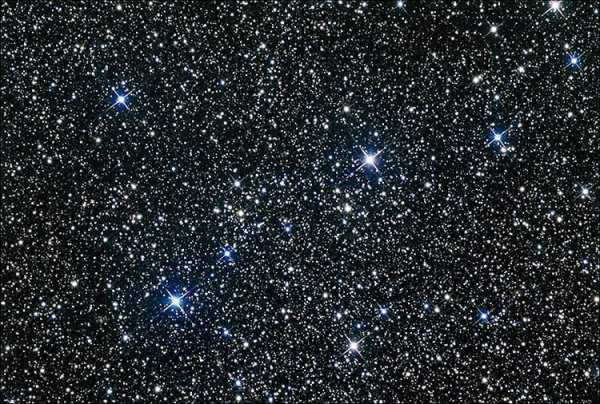
These star scatters are extraordinary, and each one can be easily counted with binoculars, as they are made up of about twenty-four individual luminaries. They stand out against the sparkling backdrop of the Milky Way.
PK 64+5.1 Planetary Nebula
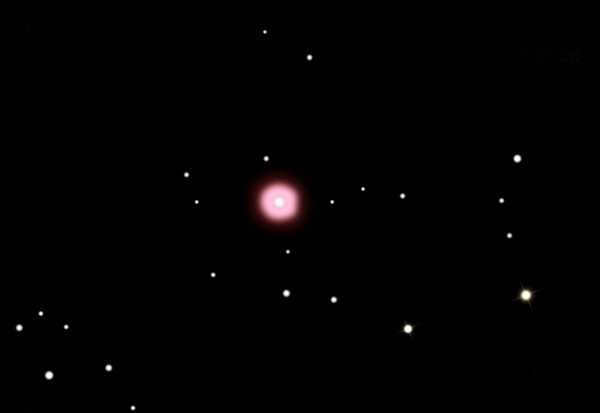
In the constellation Cygnus, there are at least two other planetary nebulae with a stellar magnitude of tenth. The brightest of them is PK 64+5.1, which is situated almost three degrees to the NNW of Albireo (β Cyg). To locate the nebula, we need to move up from Albireo for about two degrees until we reach a star with a magnitude of 4.8. Next to it, about one degree to the NE, there is a brighter star with a magnitude of 3.9. The nebula can be found at the NW apex of an equilateral triangle.
Observations of the nebula
When using any type of telescope, the nebula appears as a small star with a slightly blurred appearance and a magnitude of 9.6. Due to its star-like appearance, it can be difficult to locate. To confirm that it is indeed a nebula and not a star, a magnification of approximately 80 to 100x is necessary.
Planetary Shimmering Nebula
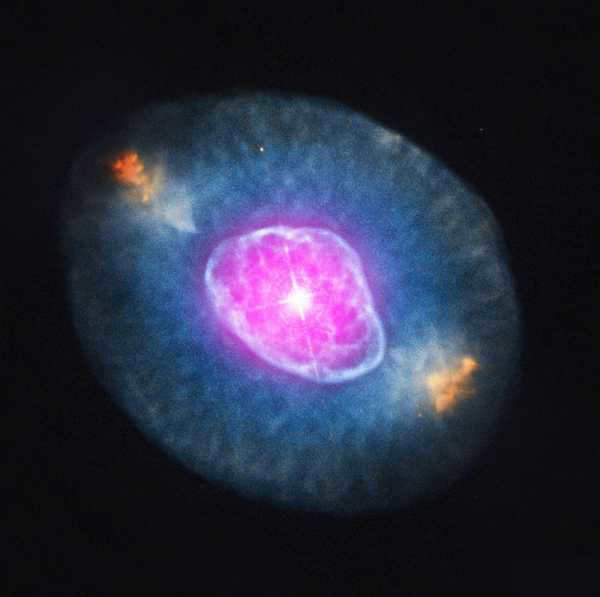
NGC 6826, a composite image, is a planetary nebula with a magnitude of 9.8. It is situated close to ι Swan. This nebula, known as the Hubble Shimmering Nebula, is well-known and can be found in the New General Catalog under the number 6826. Its location can be determined by moving two degrees southeast of ι Cyg, where a visually multiple star can be seen. This star is slightly dimmer than the starting star and one of its components is the variable R Cyg. From this star system, continue traveling 1.5 degrees East-Northeast to find NGC 6826.
To confirm the correct orientation, one can look half a degree to the North from the expected position of the nebula. If you see a graceful chain of stars bent in an arc, then you have found NGC 6826.
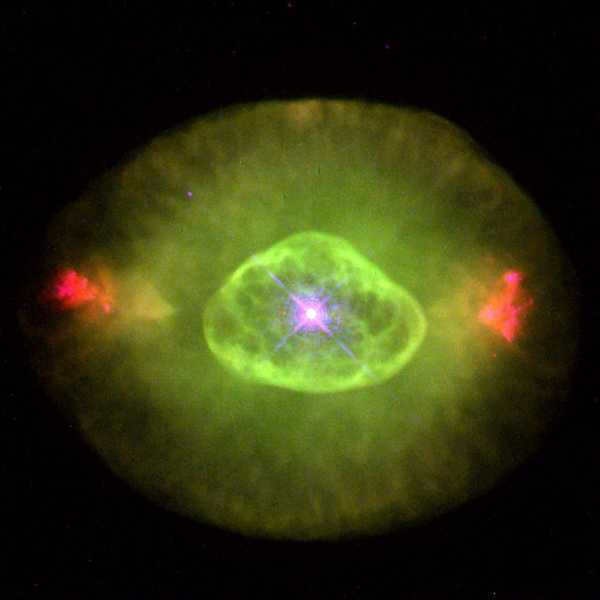
The NGC 6826, also known as the Shimmering Nebula, earned its name for a specific reason. When observed through a medium aperture telescope, it occasionally appears to change its brightness during the transition from side to direct vision. This phenomenon is caused by the double shell structure of the planetary nebula. The outer shell, which is less bright, can only be seen with side vision, while the inner shell is visible even with direct vision.
This distinct characteristic can be observed using telescopes with an aperture of 100 mm or larger. However, it may not be easily detected in smaller instruments. Despite its brightness, the nebula’s small size can make it appear similar to a star. But with perseverance and effort, the sky will reward you with the opportunity to witness this marvel of the Universe.
Constellation’s Historical Background
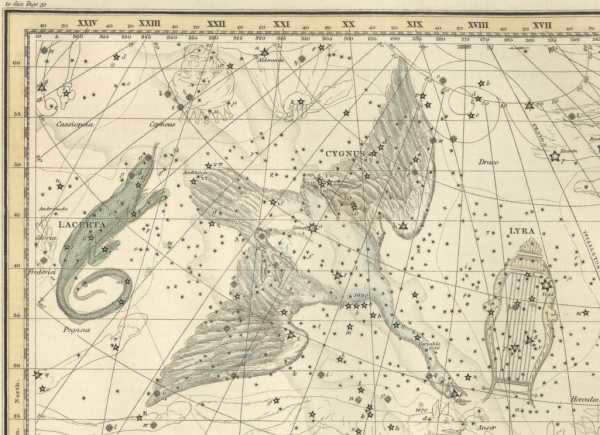

Illustration of the constellation Cygnus from an ancient celestial map
The constellation Cygnus, also known as the Swan, has been recognized since ancient times and was originally referred to as the Bird by the Greeks. One theory about the origin of the Swan in the night sky is based on a Greek myth. According to the legend, the Swan represents Jupiter (Zeus) taking the form of a bird to seduce the goddess Leda, who was the wife of Tyndareus. Another theory suggests that the constellation is associated with Cycnus, the son of Poseidon. Cycnus was abandoned by his parents and nurtured by a swan, eventually becoming deified in the form of a bird. The inclusion of this constellation in Ptolemy’s Almagest in the 2nd century further solidified its significance.
The constellation known as the swan can be found in the northern hemisphere, along the plane of the Milky Way. Its name is derived from the Latinized Greek word for “swan”. This celestial formation is easily identifiable during the summer and autumn months, and it features a distinct pattern of stars known as the Northern Cross, which should not be confused with the Southern Cross. The swan constellation was first catalogued by the ancient astronomer Ptolemy in the 2nd century, and it continues to be one of the 88 recognized constellations in modern times.
The constellation Swan, also known as the Northern Cross, is home to a variety of celestial objects. One of the most notable stars in Swan is Deneb, which is considered to be one of the brightest stars in the night sky and the most distant first magnitude star. Deneb is often referred to as the “tail star” of Swan and is also one corner of the Summer Triangle. Within Swan, there are several noteworthy X-ray sources and the giant Swan stellar association OB2.
One of the stars in the Swan stellar association OB2, known as Swan’s NML, is currently one of the largest stars that has been discovered. Additionally, Swan is the location of Swan X-1, a double X-ray system that contains a supergiant and an invisible massive companion. Swan X-1 was the first object to be widely recognized as a black hole.
Furthermore, many star systems within Swan have known planets, thanks to the observations made by the Kepler mission. The Kepler mission focused on a single patch of sky, which included the region around Swan, and resulted in the discovery of numerous exoplanets.
History and mythology
In the context of Eastern and global astronomy
In Hinduism, the time period between 4:24 and 5:12, known as Brahmamuhurta, is referred to as “the moment of the universe”. This time is considered highly auspicious for meditation, performing tasks, or starting the day. The corresponding star system is the Swan constellation.
In Polynesia, the Swan constellation was often recognized as a distinct constellation. It was called “Tuula lupe” in Tonga, “Fanui-tai” in Tuamotu, “Mara-chai” in New Zealand, “Pirae chai” or “Taurua-i-te-haapa-raa-manu” in the Society Islands, and “Fanui-raro” in Tuamotu. In New Zealand, Beta Swan was possibly named “Whetu-kaupo”. The Swan Gamma in Tuamotu was known as “Fanui-runga”.
Deneb has also been a commonly used name in the field of Islamic astronomy. The term Deneb is derived from the Arabic word dhaneb, which translates to “tail,” stemming from the phrase Dhanab ad-Dajājah, meaning “tail of the chicken.”
In Western and Greek astronomy.
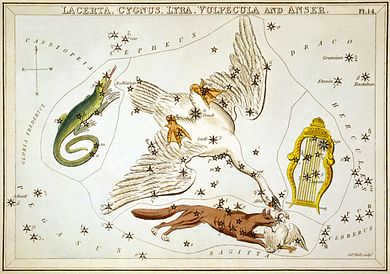
The constellation of Cygnus, also known as the Swan, is depicted in the artwork titled “the Mirror of Urania.” This set of constellation charts was published in London around 1825. Within the artwork, the Swan is surrounded by the constellations Lacerta, Fox, and Lyra.
In Greek mythology, the Swan holds significance as it is associated with various legendary swans. For instance, Zeus took on the form of a swan in order to seduce Leda, who was the wife of the Spartan king Tyndareus. As a result of their union, Leda gave birth to Gemini, Helen of Troy, and Clytemnestra. Another example is Orpheus, who transformed into a swan following his murder. It is said that he was then placed in the sky alongside his lyre, which became the constellation Lyra. Lastly, there is the tale of King Swan, who also underwent a transformation into a swan.
According to Greek mythology, the constellation was also connected to the tragic tale of Phaethon, the son of Helios, the god of the sun. Phaethon, eager to ride in his father’s chariot that carried the sun across the sky, demanded to take control during the day. However, he was unable to steer the chariot properly, leading Zeus to intervene and destroy the chariot, along with Phaethon, by striking it with lightning. The chariot crashed down to earth, plunging into the river Eridanus. It is said that Phaethon’s close friend or lover, known as Swan, mourned deeply and spent countless days diving into the river to retrieve Phaethon’s bones, so he could receive a proper burial. Touched by Swan’s unwavering devotion, the gods transformed him into a swan and placed him among the stars.
In the Metamorphoses. by Ovid. three men named Swan undergo a transformation and become swans. In addition to the aforementioned Swan, Ovid mentions a young man from Tempe who tragically takes his own life after being denied a bull by Phyllius; however, he too transforms into a swan and flies away. Ovid also recounts the story of Neptune’s son, a mighty warrior in the Trojan War who is ultimately defeated by Achilles, but is saved when Neptune transforms him into a swan.
Alongside other bird constellations such as Vultur cadens and Aquila, the Swan could potentially play a significant role in the origin of the myth surrounding the Stymphalian Birds, one of the Twelve Labors of Hercules.
Distinctive Features
Swan is an extremely expansive constellation that shares its borders with several other constellations. It is adjacent to Cepheus in the north and east, Dragon in the north and west, Lyra in the west, Foxglove in the south, Pegasus in the southeast, and Lacerta in the east. The International Astronomical Union (IAU) officially abbreviated the constellation as “Cyg” in 1922. The precise boundaries of Swan were established by Belgian astronomer Eugène Delporte in 1930 and are outlined by a polygon consisting of 28 segments. In terms of equatorial coordinates, the right ascension values range from 19 h 07.3 m to 22 h 02.3 m, while the declination values range from 27.73° to 61.36°. Covering an area of 804 square degrees, which amounts to approximately 1.9% of the night sky, Swan is the 16th largest constellation out of the total 88 constellations.
The Swan is commonly depicted with wings made up of Delta and Epsilon Swan. Deneb, which is the brightest star in the constellation, is located in its tail and Albireo is found at the tip of its beak.
There are multiple groupings of stars in Swan. According to the star atlas created by the 17th-century German cartographer Johann Bayer, known as Uranometria, Swan’s Alpha, Beta, and Gamma stars create the pole of the cross, while Delta and Epsilon stars form the transverse ray. The new star that was discovered in Swan was believed to represent the body of Christ.
Functions
Stars
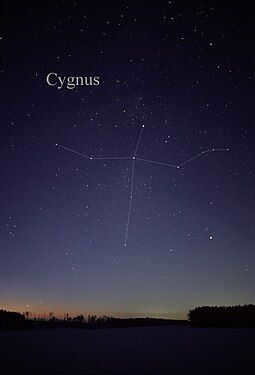
Bayer recorded a lot of the stars in the constellation and assigned them Bayer designations ranging from Alpha to Omega, and then utilized lowercase Latin letters for g. John Flemsteed included the Roman letters h, i, k, l, and m (Bayer regarded these stars as informative since they were situated outside the Swan asterism), but Francis Bailey left them out.
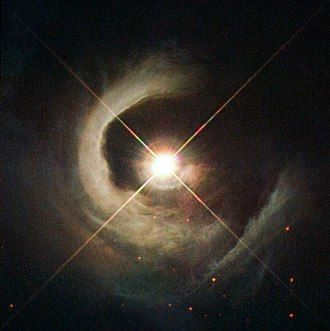
Swan X-1, a nearby X-ray source located near Eta Swan, is thought to be generated by the accretion of matter from a black hole in a binary star system. Many initially believed it to be the first black hole emitting X-rays. This fascinating phenomenon is situated approximately 2.2 kiloparsecs away from our Sun. Furthermore, the system includes HDE 226868, a variable star of supergiant proportions.
There has been a lot of media attention on the star KIC 8462852 (also known as Tabby’s Star) due to its remarkable changes in brightness.
Swan is a constellation that has been extensively studied by the Kepler satellite in its quest to find exoplanets. As a result, Swan boasts a remarkable number of stars with known planets, surpassing any other constellation in this regard. One particularly noteworthy system within Swan is the Kepler-11 system, which is home to six exoplanets that transit their star in a nearly flat plane. This system was the first to have six exoplanets discovered within it. The star at the center of the Kepler-11 system has a spectral class of G6V and is slightly cooler than our own Sun. The planets in this system are incredibly close to their star; in fact, all but the last planet orbit closer to Kepler-11 than Mercury does to the Sun. Additionally, all of the planets in this system are larger than Earth and have low densities.
Another intriguing star within Swan that can be seen with the naked eye is 16 Swan. This star is actually a triple star system located approximately 70 light-years away from Earth. It consists of two sun-like stars and a red dwarf. Interestingly, one of the sun-like stars in this system has been found to have a planet orbiting around it. This planet was detected due to variations in the star’s radial velocity.
Gliese 777 is yet another multiple star system within Swan that can be seen without the aid of a telescope. It consists of a yellow star and a red dwarf, and it too has a planet in its midst. This planet is somewhat similar to Jupiter, but it has a slightly higher mass and a more eccentric orbit.
Finally, the Kepler-22 system is worth mentioning for its status as the most Earth-like exoplanet at the time of its discovery in 2011.
Objects in the depths of space
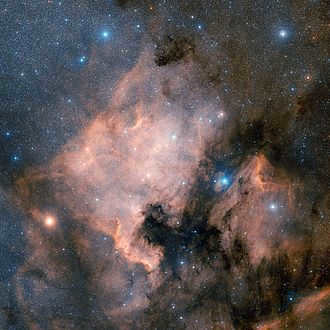
Swan constellation is home to a multitude of celestial bodies, ranging from scattered clusters and diverse nebulae to remnants of supernovas. These objects are abundant in Swan due to its location within the Milky Way. However, some of the scattered clusters may pose challenges in terms of differentiation, as they blend seamlessly with the surrounding dense stellar background.
The Shimmering Planetary Nebula, also known as NGC 6826, is a planetary nebula located 3,200 light-years away from Earth. With a magnitude of 8.5, it showcases a mesmerizing display of lights and colors. When observed through a telescope, it appears to “blink” due to the unusually bright central star, which has a magnitude of 10. Focusing on the star causes the nebula to seemingly vanish from sight. In close proximity, merely less than one degree away, lies the double star 16 Swan.
The North America Nebula, also known as NGC 7000, is a well-known celestial object in the constellation of Cygnus. It stands out among other nebulae due to its visibility to the naked eye in areas with minimal light pollution. Its distinct shape, resembling the continent of North America, is most easily observed in long exposure photographs. However, due to its low surface brightness, it can be challenging to study directly through telescopes. This is primarily because of its immense size, with a diameter of approximately 2 degrees. Situated roughly 1,500 light-years away from our planet, the North America Nebula is illuminated by a hot embedded star with a magnitude of 6th.
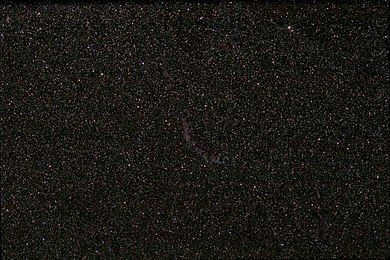
Photographed from a remote location, this image showcases the NGC 6992 (Eastern Veil Nebula – center) and NGC 6960 (Western Veil Nebula – top right).
Situated just south of Epsilon Swan, the Veil Nebula (NGC 6960, 6979, 6992 and 6995) is a supernova remnant that dates back 5000 years. Spanning approximately 3 degrees of the sky, it stretches over 50 light years in length. Known also as the Swan Loop due to its appearance, this celestial feature can only be fully appreciated through long-exposure astrophotography. However, the NGC 6992, the brightest section, can be faintly observed using binoculars, while the dimmer NGC 6960 can be seen with wide-field telescopes.
The DR 6 cluster is nicknamed the “Galactic Ghoul” due to its resemblance to a human face.
The Northern Coal Sack Nebula, also known as the Swan Rift, is a dark nebula situated within the Swan Milky Way.
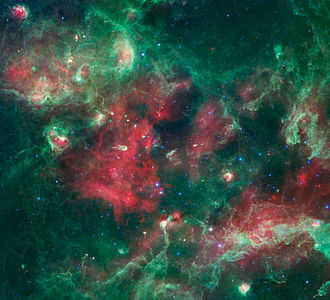
Additionally, it is worth mentioning the presence of the Crescent Nebula (NGC 6888) situated between Gamma and Eta Swan. This celestial wonder was brought into existence by the Wolf-Raye star HD 192163.
In recent years, the Swan has been the subject of several remarkable findings by amateur astronomers. One such discovery is the “Soap Bubble Nebula” (PN G75.5+1.7), which was first observed in a digital image captured by Dave Jurasiewicz in 2007. This nebula is located adjacent to the Crescent Nebula. Another significant finding was made by Austrian amateur Matthias Kronberger in 2011. He stumbled upon a planetary nebula (now known as Kronberger 61 but affectionately nicknamed “Soccer Ball”) in old survey photographs. This discovery has recently been verified by images from the Gemini Observatory. Both the Soap Bubble Nebula and Kronberger 61 are likely too faint to be visible through a small amateur telescope.
However, an object that is much more obscure and relatively small can be easily observed in dark skies using amateur telescopes, especially under favorable conditions. This particular object is a recently discovered nebula, which is believed to be of the reflective type. It is associated with the star 4 Swan (HD 183056) and appears as a roughly fan-shaped luminous region with a diameter of a few angular minutes. This nebula can be observed to the south and west of the fifth-magnitude star. The discovery of this nebula was first made visually near San Jose, California, by amateur astronomer Stephen Waldie in 2007. It was publicly reported by Waldie and later confirmed by photographer Al Howard in 2010. However, Waldie did not publish his findings for others to confirm and analyze until his official notifications and a subsequent 2010 paper.
Swan A was the first radio galaxy to be discovered. It is located approximately 730 million light-years away from Earth, making it the closest powerful radio galaxy. In the visible spectrum, it appears as an elliptical galaxy within a small cluster. Scientists classify Swan A as an active galaxy because it contains a supermassive black hole at its core that accretes matter. This matter then generates two jets of matter that shoot out from the poles. These jets interact with the interstellar medium, creating radio clouds and emitting radio waves.
Additionally, Swan A seems to be a source of WIMP, or Weakly Interacting Massive Particles, due to the orientation of the solar system’s rotation as it moves through the galactic halo.
Additional resources
References
Recommended reading
- Allen, R. H. (1963). Star names: their knowledge and significance (Reprint). New York, NY: ISBN Dover Publications Inc.978-0-486-21079-7 .
- Levy, David H. (2005). Objects of deep space . Prometheus Books. ISBN978-1-59102-361-6 .
- Makemson, Maud Worcester (1941). The rising of the morning star: an account of Polynesian astronomy . Yale University Press. Bibcode : 1941msra.book. M .
- Ridpath, Jan; Tirion, Wil (2001), A guide to the stars and planets , Princeton University Press, ISBN978-0-691-08913-3
- Jan Ridpath and Wil Tirion (2007). A guide to the stars and planets , Collins, London. ISBN978-0-00-725120-9 . Princeton University Press, Princeton. ISBN978-0-0-691-13556-4 .
External Links
- An extensive photographic guide to the constellations: Swan
- A detailed mosaic of Northern Cygnus, allowing you to zoom in and explore deep space objects in the Cygnus region.
- A clickable guide to Swan
- Star Tales – Learn more about the mythological significance of the Swan constellation
- Discover the Swan Nebula and its stunning features
- Explore the Warburg Institute iconographic database for medieval and early modern depictions of the Swan
The Swan constellation is located in the northern hemisphere and can be seen along the plane of the Milky Way. Its name is derived from the Latinized Greek word for swan. Swan is easily recognizable and is especially prominent during the summer and autumn months in the northern sky. It features a notable asterism known as the Northern Cross, which should not be confused with the Southern Cross. Swan was originally cataloged by the ancient astronomer Ptolemy and is still recognized as one of the 88 modern constellations.
The constellation Cygnus, also known as the Swan or the Northern Cross, is home to a variety of celestial phenomena. One notable feature is the star Deneb, which is located at the tail of the Swan and is one of the brightest stars in the night sky. It is also the most distant first magnitude star and forms one of the corners of the Summer Triangle. Cygnus is also known for its association with the giant star group Cygnus OB2, which includes the massive star NML Cygni, one of the largest stars currently known.
Furthermore, Cygnus contains several notable X-ray sources, including the distant X-ray double system Cygnus X-1. This system is composed of a supergiant star and an unseen massive companion, which many believe to be a black hole. Cygnus is also of particular interest due to the presence of exoplanets. The Kepler Mission, which observed a specific section of the sky, discovered numerous star systems within the region around Cygnus that are known to harbor planets.
In a large portion of the eastern region, you can find a section of the Great Wall of Hercules, the Borealis in the vast expanse of the night sky, a colossal strand of galaxy that is the most expansive known structure in the visible universe, encompassing a significant portion of the northern sky.
- 1 History and mythology
- 1.1 In the realm of eastern and global astronomy.
- 1.2 In the context of Western and Greek astronomy
- 3.1 Stars
- 3.2 Celestial objects in the deep sky
Historical and mythical background
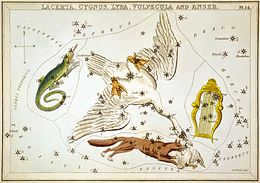
The constellation Swan can be seen in The Mirror of Urania, a collection of maps depicting constellations that was published in London in approximately 1825. It is surrounded by the constellations Lacerta, Foxglove, and Lyra.
In Eastern and Global Astronomy.
In Hinduism, the time period known as Brahmamuhurta, which occurs from 4:24 to 5:12 a.m., is considered to be very auspicious. This time is often referred to as “the moment of the universe”, and it is associated with the constellation Swan. Many people choose to meditate, engage in tasks, or start their day during this time.
Deneb was a commonly used name in the field of astronomy in the Islamic world. The term Deneb is derived from the Arabic word dhaneb, which means “tail”, originating from the phrase Dhanab al-Dajjaja, which translates to “tail of the chicken”.
Regarding Western and Greek astronomy.
In Greek mythology, the Swan was associated with various legendary swans. Zeus took the form of a swan to seduce Leda, the wife of Spartan king Tyndareus, who gave birth to Gemini, Helen of Troy, and Clytemnestra. Orpheus, after his murder, transformed into a swan and was said to be placed in the sky alongside his lyre (Lyra). Additionally, King Swan also transformed into a swan.
In Greek mythology, the constellation of Cygnus was associated with the tragic tale of Phaethon, son of Helios, the god of the sun. Phaethon had a strong desire to experience a day in his father’s solar chariot, but his lack of skill in controlling the reins led to a disastrous outcome. Zeus, the king of the gods, had to intervene and destroyed the chariot (and Phaethon) with a powerful lightning strike. The wreckage of the chariot fell from the sky and landed in the Eridanus River on Earth.
Phaethon’s dear friend or lover, known as Swan, was filled with grief and mourned his loss deeply. Swan spent many days diving into the river to retrieve Phaethon’s scattered bones, determined to give him a proper burial. The gods were deeply moved by Swan’s unwavering devotion, and as a reward, they transformed him into a majestic swan and placed him among the stars.
In Ovid’s Metamorphoses, there are three individuals named Cygnus, all of whom undergo a transformation into swans. In addition to the aforementioned Swan, Ovid mentions a young boy from Tempe who tragically ends his own life when he is denied the tamed bull he desires. However, he too transforms into a swan and takes flight. Ovid also references Neptune’s son, a formidable warrior who fought in the Trojan War and was eventually defeated by Achilles. Yet, Neptune intervenes and transforms him into a swan, saving his life.
Alongside other avian constellations such as Vultur cadens and Aquila, the Swan potentially plays a significant role in the origins of the myth surrounding the Stymphalian Birds, one of the Twelve Labors of Hercules.
Distinctive Features
Swan, an expansive constellation, is situated adjacent to several other constellations. It is bordered by Cepheus to the north and east, Draco to the north and west, Lyra to the west, Foxglove to the south, Pegasus to the southeast, and Lacerte to the east. This constellation was assigned the three-letter designation “Swan” by the International Astronomical Union (IAU) in 1922. Belgian astronomer Eugène Delporte established the official constellation boundaries in 1930, which consist of a polygon with 28 segments. In terms of equatorial coordinates, the boundaries of Swan span from 19 07.3 to 22 02.3 in right ascension and from 27.73° to 61.36° in declination. Covering an area of 804 square degrees, Swan occupies approximately 1.9% of the night sky and is ranked as the 16th largest constellation out of the total 88 constellations.
Swan reaches its peak at midnight on June 29 and is most easily seen in the evening during the early to mid-summer season. -Autumn in the Northern Hemisphere.
Swan is commonly portrayed with Delta and Epsilon Swan acting as its wings. Deneb, the brightest star in the constellation, is located in its tail, and Albireo is found at the tip of its beak.
There are multiple asterisms within Swan. According to the star atlas created by the 17th-century German celestial cartographer Johann Bayer, Uranometria, Alpha, Beta, and Gamma of Swan make up the pole of the cross, while Delta and Epsilon form the transverse ray. The newly discovered star, P Swan, was once believed to represent the body of Christ.
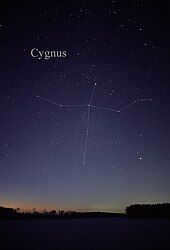
The constellation of the Swan, which can be observed without the aid of a telescope, contains the Northern Cross at its core.
Stellar Objects
Bayer meticulously cataloged the numerous stars within the constellation, assigning them Bayer designations ranging from Alpha to Omega, and then utilizing lowercase Latin letters from g. John Flemsteed later included the Roman letters h, i, k, l, and m (Bayer excluded these stars from the Swan asterism due to their informative nature), while Francis Bailey.
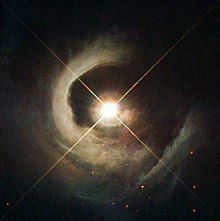
V1331 Cyg is located within a dense nebula.
In the constellation Swan, there are multiple brilliant stars. Deneb, the Alpha star of Swan, shines the brightest. It is a white supergiant star classified as A2Iae, and its magnitude ranges from 1.21 to 1.29. Deneb is one of the largest and most luminous A-class stars known to us, located approximately 3,200 light-years away. The star’s traditional name, which means “tail,” refers to its position within the constellation.
Among amateur astronomers, Albireo, also known as Beta Swan, is a famous double star due to its strikingly different colors. The primary star is a giant orange-colored star with a magnitude of 3.1, while the secondary star is a blue-green star with a magnitude of 5.1. This system is situated 380 light-years away and can be observed with large binoculars or any amateur telescope.
Gamma Swan, traditionally called Sadr, is a yellow-colored supergiant with a magnitude of 2.2. It is located 1,500 light-years away. The star’s traditional name, meaning “breast,” refers to its position in the constellation.
Another notable double star in Swan is Delta Swan (also known as Favaris). This star system spans 171 light-years and has a period of 800 years. The primary star is a giant blue-white star with a magnitude of 2.9, while the secondary star has a magnitude of 6.6. Both components of this double star can be observed using a medium-sized amateur telescope.
The fifth star in Swan with a magnitude above 3 is Aljana, denoted as Epsilon Swan. This giant orange-colored star has a magnitude of 2.5 and is located 72 light-years away from Earth.
Swan contains numerous other double and binary stars that exhibit dimmer characteristics. Mu Swan, for example, is a double star that possesses an optical tertiary component. This double system has a period of 790 years and is located approximately 73 light-years away from Earth. The primary and secondary stars, both of which are white in color, have stellar magnitudes of 4.8 and 6.2, respectively. In contrast, the unbound tertiary component has a magnitude of 6.9. While the tertiary star can be observed with binoculars, the primary and secondary stars currently necessitate the use of a medium-sized amateur telescope for proper separation. This will continue to be the case throughout the year 2020. Between the years 2043 and 2050, however, the two stars will be at their closest point of proximity and will require a telescope with a larger aperture for proper separation. Stars 30 and 31 of Swan form an intriguing double star that shares similarities with the brighter Albireo. Both stars can be observed using binoculars. The first star, known as 31 Swan, is an orange-colored star with a magnitude of 3.8. It is positioned approximately 1,400 light-years away from Earth. On the other hand, the secondary star, 30 Swans, has a blue-green appearance and is classified as a spectral type A5IIIn. It possesses a magnitude of 4.83 and is situated around 610 light-years away from Earth. 31 Swan is actually a double star, with its tertiary component being a blue star that possesses a magnitude of 7.0. Psi Swan is another double star that can be observed using small amateur telescopes. It consists of two white components, with the primary star having a magnitude of 5.0 and the secondary star having a magnitude of 7.5. 61 Swan, on the other hand, is a double star that can be seen with large binoculars or a small amateur telescope. It is located approximately 11.4 light-years away from Earth and has a period of 750 years. Both components of 61 Swan are classified as orange dwarf stars (main sequence), with the primary star possessing a magnitude of 5.2 and the secondary star having a magnitude of 6.1. What makes 61 Swan noteworthy is that Friedrich Wilhelm Bessel was able to determine its parallax in 1838, making it the first star to have a known parallax.
Adjacent to the Swan, there lies the Swan X-1, an X-ray source that is now attributed to the accretion of matter by a black hole in a binary star system. It was the initial X-ray source that many considered to be a black hole.
The two stars comprising Albireo can be easily distinguished, even when observed through a modest telescope.
Swan also hosts several other notable sources of X-rays. Cygnus X-3 is a microquasar that contains a Wolf-Rayet star in orbit around an incredibly compact object, and it completes one orbit every 4.8 hours. This particular system is among the brightest of all observed X-ray sources. Periodic flares of unknown origin occur within the system, and it was discovered that during one of these flares, the system emitted muons, likely caused by neutrinos. While scientists believe that the compact object is most likely a neutron star or possibly a black hole, there is a possibility that it could be an even more exotic stellar remnant – potentially the first-ever discovered quark star. This hypothesis arises from the fact that the object produces cosmic rays that cannot be explained if it were a normal neutron star. Additionally, the system emits cosmic rays and gamma rays, which have provided valuable insights into the formation of such rays. There is another X-ray double system in Swan that consists of an A-type giant star orbiting a neutron star with a period of 9.8 days. This system is intriguing due to the relatively small mass of the companion star, as most millisecond pulsars have significantly more massive companions. Finally, there is another black hole in Swan known as V404 Cygni. It is composed of a K-type star orbiting a black hole with a mass roughly equivalent to 12 times that of the Sun. The black hole resembling Swan X-3 is believed to be a quark star. – There is also another X-ray double star that contains a neutron star, which, as it turns out, undergoes flares.
Swan is also a habitat for several types of stars that can change in brightness. SS Cygni is a small nova that experiences bursts every 7-8 weeks. The overall brightness of the system ranges from 12th magnitude when it is dimmest to 8th magnitude when it is brightest. Two objects in the system are very close to each other and complete an orbit in less than 0.28 days. Chi Swan is a red giant and the second brightest variable star named Myra at its brightest. It varies in brightness from 3.3 to 14.2 and has spectral classes ranging from S6.2e to S10.4e (MSe) over a period of 408 days. It has a diameter that is 300 times that of the Sun and is located 350 light years away from Earth. P Cygni is a bright blue star that suddenly became visible as a 3rd magnitude star in 1600 AD. Despite being more than 5,000 light years away from Earth, it has maintained a magnitude of 5th since 1715. The star’s spectrum is unusual because it contains very strong emission lines caused by the surrounding nebula. W Cygni is a red giant star that varies in brightness regularly. It is located 618 light years away from Earth. It has a maximum brightness of 5.10 and a minimum brightness of 6.83, with a period of 131 days. It is classified as a red giant with spectral types M4e-M6e (Tc:) III. NML Cygni is a red hypergiant star that varies in brightness and is located 5300 light years away from Earth. It is one of the largest stars currently known in the galaxy, with a radius that is greater than 1000 times that of the Sun. Its stellar magnitude is approximately 16.6 and it has a period of about 940 days.
The Swan constellation houses the binary star system known as KIC 9832227. It is predicted that these two stars will combine in approximately 2022, resulting in the creation of a temporary celestial body that can be observed without the aid of a telescope.
Swan is a constellation that has been extensively studied by the Kepler satellite in its search for planets outside of our solar system. As a result, Swan has the highest number of known planets among all constellations, with approximately one hundred stars hosting planets. One of the most well-known systems in Swan is the Kepler-11 system, which consists of six planets that transit their star in a relatively flat orbit. The star in this system, classified as a G6V, is slightly cooler than our Sun. The planets in the Kepler-11 system orbit very close to their star, with all but the last planet being closer to their star than Mercury is to the Sun. Additionally, all of the planets in this system are more massive than Earth.
Another interesting star in Swan is 16 Swan, which is visible to the naked eye and located about 70 light-years away from Earth. This star is actually a triple star system, composed of two stars similar to our Sun and a smaller red dwarf star. Scientists have detected a planet orbiting one of the Sun-like stars in this system by observing variations in the star’s radial velocity.
In addition to 16 Swan, there is another multiple star system in Swan called Gliese 777. This system is also visible to the naked eye and consists of a yellow star and a red dwarf star. Scientists have discovered a planet in this system that is somewhat similar to Jupiter, but with a slightly larger mass and a more eccentric orbit.
Finally, the Kepler-22 system is worth mentioning as it is believed to host the first extrasolar planet that closely resembles Earth. This planet, known as a doppelganger planet, has similar characteristics to our own planet.
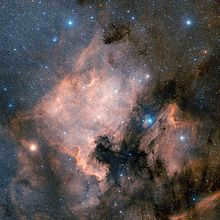
314>The North America Nebula (NGC 7000) is an incredibly renowned nebula in the Cygnus constellation.
In Cygnus, there are numerous deep space entities, including various types of nebulae, scattered clusters, and remnants of supernovas. The position of Cygnus on the Milky Way allows for the presence of these celestial objects. However, some of the scattered clusters may be challenging to discern amidst the vast expanse of stars in the sky.
M39 (NGC 7092) is an expansive cluster located 950 light-years away from Earth that can be observed without the need for any optical aid, provided that the sky is dark enough. It is not tightly packed, and its approximately 30 stars are scattered over a wide area, forming a triangular shape. The most luminous stars in M39 have a stellar magnitude of 7, making them easily visible. Another loose cluster in the constellation Cygnus is NGC 6910, also known as the Rocking Horse cluster. It consists of 16 stars, forming a cluster that spans 5 minutes of arc in diameter, which can be observed using a small amateur telescope. This cluster has a magnitude of 7.4. The most prominent stars in NGC 6910 are two golden stars that resemble the bottom part of a rocking horse, which is how the cluster got its name. With a larger amateur telescope, it is possible to observe an additional 8 stars, as well as a nebula that extends both to the east and west of the cluster, covering an area of 9 arc minutes in diameter. This nebula is a part of the Gamma Swan Nebula. Most of the other stars in the vicinity, which are located about 3700 light-years away, appear blue-white in color and emit a large amount of heat.
There are other random groups of stars in the Swan constellation, including Dolidze-9 and Dolidze-11. Dolidze-9 is located 2,800 light-years away from Earth and is relatively young, only 20 million years old. It is a faint cluster with 22 stars that can be seen with small to medium amateur telescopes. The cluster is 7 angular minutes in diameter and has a nebula to the north and east. The brightest star in Dolidze-9 is in the eastern part of the cluster and has a magnitude of 7; there is also another bright star with a yellow hue. Dolidze-11, on the other hand, is a scattered cluster that is 400 million years old and located 3,700 light-years away. It is the farthest of the three clusters mentioned. Similar to Dolidze-9, it is also 7 arc minutes in diameter and has a nebula in the east. It has more than 10 stars visible in an amateur telescope, with the brightest star having a magnitude of 7.5.
Another scattered cluster in Swan is Collinder 421, which is particularly old, approximately 1 billion years old. It is located 3,100 light-years away from Earth and has a magnitude of 10.1. This cluster has more than 30 stars visible at a diameter of 8 angular seconds. The prominent star in the north of the cluster is golden in color, while the stars in the south of the cluster appear orange. Collinder 421 also appears to be surrounded by a nebula that extends beyond its boundaries to the west.
Lastly, there is Berkeley-90, a small scattered cluster that is 5 angular minutes in diameter. It has more than 16 members that can be seen in an amateur telescope.
The Blinking Planetary Nebula, also known as NGC 6826, is located approximately 3200 light years away from Earth. It is called the “Blinking Planetary Nebula” because when observed through a telescope, it appears to intermittently disappear and reappear. This optical illusion is caused by its central star, which has a brightness of 10th magnitude, making it unusually bright. Interestingly, when the observer focuses on the star, the nebula seems to vanish from view. A fascinating celestial object located within close proximity, less than one degree away, is the double star known as 16 Swan.
The North America Nebula (NGC 7000) is renowned for being one of the most well-known nebulae in the Swan constellation. It stands out in the night sky, visible to the naked eye in areas with minimal light pollution, appearing as a luminous spot within the Milky Way. However, its distinctive shape is best captured through long exposure photography, making it challenging to observe directly through telescopes due to its low surface brightness. This nebula’s large size contributes to its low surface brightness, with a diameter of 2 degrees at its widest point. Situated approximately 1500 light years away from Earth, NGC 7000 is illuminated by a hot embedded star with a magnitude of 6.
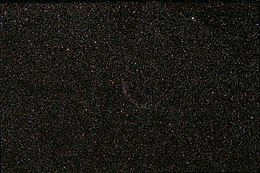
NGC 6992 (Eastern Veil Nebula – center) and NGC 6960 (Western Veil Nebula – top right) were captured in this image taken from a remote and dark location.
Just to the south of Epsilon Swan lies the Petal Nebula (NGC 6960, 6962, 6979, 6992, and 6995), a remnant from a supernova explosion that occurred 5000 years ago and now spans approximately 3 degrees of the sky, equivalent to over 50 light years. This nebula is also known as the Swan Loop due to its distinctive shape. The loop can only be seen in long-exposure astrophotographs. However, the brightest section, NGC 6992, can be faintly observed with binoculars, while the dimmer part, NGC 6960, is visible with wide-field telescopes.
The DR 6 cluster has earned the nickname “The Galactic Goole” because of its resemblance to a human face.
The Northern Coal Sack Nebula, also known as the Swan Rift, is a dark nebula situated within the Swan Milky Way.
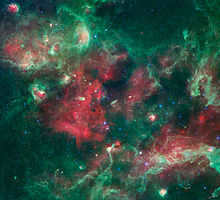
Swan X is a vast area in the constellation Swan where stars are actively being formed.
The Swan gamma-ray nebula (IC 1318) consists of various bright and dark nebulae spanning over an area larger than 4 degrees. It is one of the numerous emission nebulae in the Swan constellation, with dimensions of approximately 7.8 by 4.3 arc minutes. Located within the Gamma region of Swan, this nebula is accompanied by two other emission nebulae. When observed using an amateur telescope, Sharpless 2-112 appears as a spherical shape. A significant portion of the nebula’s eastern section can be seen when using an O III (doubly ionized oxygen) filter. Adjacent to the nebula is a 10th magnitude orange star, while a 9th magnitude star can be found near its northwestern edge. Moving towards the northwest, there is a dark crevice and another prominent bright area. The entire nebula has a diameter of 15 angular minutes. Sharpless 2-115 is another emission nebula characterized by a complex arrangement of bright and dark regions. Within this extensive nebula, there are two pairs of stars, with the southwestern pair featuring a larger star. Contained within this vast nebula is the scattered cluster known as Berkeley 90, measuring approximately 30 by 20 arc minutes.
There have been a number of significant findings of the Swan made by amateur astronomers in recent times. In 2007, Dave Jurasiewicz discovered the Soap Bubble Nebula (PN G75.5 + 1.7) near the Crescent Nebula through a digital image. In 2011, Matthias Kronberger, an Austrian amateur, stumbled upon a planetary nebula (now known as Kronberger 61 and affectionately referred to as “Soccer Ball”) in old overview photographs, which has since been confirmed by images captured by the Gemini Observatory. Both of these discoveries are likely too dim to be visible through a small amateur telescope.
However, there is another object that is much darker and relatively small, making it easy to observe with amateur telescopes under optimal conditions in dark skies. This object is a recently discovered nebula, most likely of the reflecting type, and it is associated with the star 4 Swan (HD 183056). The nebula takes the form of a fan-shaped luminous region, with a diameter of a few angular minutes, situated to the south and west of the fifth magnitude star. Its existence was first visually detected by amateur astronomer Stephen Waldie in 2007 near San Jose, California. It was publicly reported by Waldie and later confirmed through photographic evidence by Al Howard in 2010. Additionally, California amateur astronomer Dana Patzik claims to have discovered the nebula in survey photos taken at the Palomar Observatory in 2005. However, Patzik did not publish his findings for confirmation and analysis by others until after the initial reports by Waldie and the subsequent 2010 publication by Howard.
Swan X, the largest star-forming region near the Sun, contains not only some of the most brilliant and massive stars ever discovered (such as Cygnus OB2-12), but also Cygnus OB2, a massive stellar association that some researchers classify as a young globular cluster.
Going into more detail, the Firework Galaxy (NGC 6946) has witnessed more supernovae than any other galaxy.
Swan A holds the distinction of being the very first radio galaxy ever detected. Located just 730 million light-years away from Earth, it is also the closest powerful radio galaxy. In the visible spectrum, Swan A presents itself as an elliptical galaxy within a small cluster. It is categorized as an active galaxy due to the presence of a supermassive black hole at its core that is actively accreting matter and generating two jets of material from its poles. The interaction of these jets with the surrounding interstellar medium creates radio wave lobes, which serve as one source of radio emissions.
The swan is also believed to be a source of the WIMP-wind, which is influenced by the orientation of the solar system’s rotation through the galactic halo.
Related
References
Bibliography
- Allen, RH (1963). Star names: their knowledge and significance (Reprint). New York, NY: Dover Publications Inc. ISBN 978-0-486-21079-7.
- Levy, David H. (2005). Deep Sky Objects. Prometheus Books. ISBN 978-1-59102-361-6. CS1 maint: ref=harv (link)
- Makemson, Maud Worcester (1941). Star Rises morning: an account of Polynesian astronomy. Yale University Press. Bibcode: 1941msra.book.M. CS1 maint: ref=harv (link)
- Ridpath, Jan; Tirion, Wil (2001), Handbook of Stars and Planets, Princeton University Press, ISBN 978-0-691-08913-3
- Jan Ridpath and Wil Tirion (2007). Guide to Stars and Planets, Collins, London. ISBN 978-0-00-725120-9 . Princeton University Press, Princeton. ISBN 978-0-691-13556-4 .
External links
| Wikimedia Commons has media files related to: Cygnus ( constellation ) (category ) |
| Wikisource has the text of the 1911 Encyclopædia Britannica article Cygnus. |
- The Deep Photographic Guide to the Constellation: Cygnus
- Mosaic of the northern Swan Panning and zooming in on deep space objects in the Swan.
- Pressing the Cygnus button
- Star Tales – Cygnus
- 4 Swan Nebula
- Iconographic database of the Warburg Institute (over 140 medieval and early modern images of Cygnus)
Coordinates: 20 37 12, + 42° 01 ′ 48″

Astronomy enthusiasts are well aware of the renowned bright cluster located in the northern hemisphere. The constellation Cygnus was named by ancient civilizations due to the distinctive arrangement of stars that form its shape. As a result, the ancient legend surrounding the creation of this “celestial waterfowl” has become quite popular. In this article, we will not only delve into the description of Cygnus, but also explore its…
Overview
IMPORTANT: Known as Cygnus in Latin, this constellation has a right ascension ranging from 19 hours, 05 minutes to 21 hours, 58 minutes, and a declination ranging from +27 degrees 30 minutes to +60 degrees 55 minutes.
The cluster covers an area of 84 square deg. and ranks sixteenth on the list of the largest known clusters. The brightest stars in Cygnus include Deneb (1.25m), Sadr (2.23m), and Gienah (2.48m to 2.87m). It is interesting to note that all these names have Arabic origins.
The legend of the constellation Cygnus
In ancient times in Sparta, the hero Tyndareus was exiled due to a political uprising led by his brother Hippokontes. For a considerable period, Tyndareus wandered, visiting various states, yet he never found a new homeland. However, fate smiled upon him when he arrived in the land of Aetolia, ruled by King Testius. Not only was Tyndareus warmly welcomed as a cherished guest, but he also formed a deep friendship with the king, leading to his marriage to Testius’ beautiful daughter, Leda. Together, Tyndareus and Leda experienced a blissful existence.
Time passed, and news reached them from Sparta. Heracles had slain Hippokontos and all his sons. This meant that Tyndareus could finally return to his homeland, accompanied by Leda. The indescribable beauty and allure of Leda captivated all Spartans. Tales of her divine appearance spread throughout Greece. It was rumored that such beauty could only belong to goddesses… This caught the attention of Zeus, who immediately became infatuated with Leda. However, he had to find a way to pursue her without alerting his jealous wife, Hera, to their connection. In a stroke of brilliance, Zeus transformed himself into a majestic white swan and descended from the heights of Mount Olympus to Sparta, where Leda awaited.
The complete constellation of the most brilliant celestial bodies is known as the Northern Cross. The alpha star in the constellation of the Swan is called Deneb. Deneb is a supergiant star with a blue-white color, located at a distance of 1.4 thousand light-years from us. It has a visible magnitude of 1.25, making it the 19th brightest star on the list. Deneb belongs to the class of variable stars, meaning its brightness and spectral characteristics can change. The star has already stopped fusing hydrogen in its core and is expected to explode as a supernova in the near future.
Another notable star in the Swan constellation is Sadr, also known as Swan gamma-ray. Sadr is a whitish supergiant star with a spectral type of F8. It has a mass that is 12 times greater than that of the Sun, which causes it to rapidly consume nuclear fuel. With an apparent size of 2.23, Sadr is among the brightest stars. Sadr is relatively young, at 12 million years old. Surrounding Sadr is a diffuse nebula called IC 1318.
Genach, also known as Jenach, is the epsilon star of the depicted constellation. It is a massive orange star classified as K0 III. It is a staggering 62 times larger than our Sun and has a radius 11 times greater. The “wing” of the Swan constellation is connected with the constellation Raven, which shares the same name as the gamma star of the respective constellation.
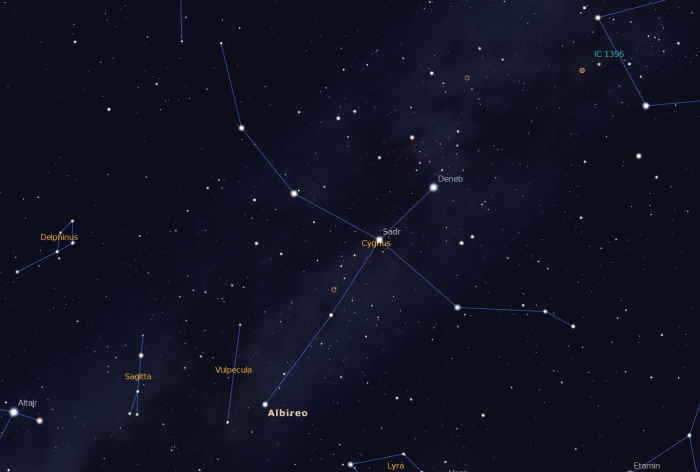
Celestial objects found within the constellation
- The Northern Coal Sack;
- The North America and Pelican Nebulae;
- The observation of NGC 7000;
- The Pelican Nebula;
- The M 39 scattered star cluster;
- The M 29 star cluster;
- The Veil Nebula;
- The Witch’s Broom Nebula;
- The N.G.C. 7082 and 7039 objects;
- The shimmering phenomenon.





